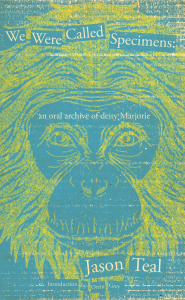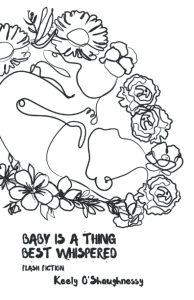Fiction. 24o pgs. Verso Books. October 2020. ISBN: 978-1-788738-95-8.
“I hate God,” Jenny Hval’s narrator begins in her novel Girls Against God.“What a smug thing to say, but I’m pretty smug. (Isn’t ‘me’ just a different word for ‘God?’)” And thus, a story opens, in the loosest possible terms—a story whose single organizing principle seems to be the idea of hatred itself. Girls Against God is a mind-bending, nonlinear coming of age tale that follows a nameless narrator during her adolescence in provincial Southern Norway and through her early adulthood in Oslo—though, the events of the novel don’t occur in that order, if they can be classified as “events” at all. Hval dips in and out of exposition describing the narrator’s actions and whereabouts, using these plot elements only as a starting point from which to dive into free-flowing polemical passages about heavy metal, sex, the Internet, and Edvard Munch. The salient concepts that tether us to the heart of this story are the narrator’s hatred of the oppressive structures of Christianity, capitalism, and patriarchy, and her contrasting passion for alternative, underground sites of community—namely, the social scenes she carves out for herself in her practices of witchcraft and heavy metal music. To put it more simply, the narrator reveres all that is communal and decadent—her coven, her band, and their banquets—and despises all that is moralizing and solipsistic—the concept of ‘God’ itself embodying capitalistic selfishness on a grand scale—“(Isn’t ‘me’ just a different word for ‘God’?).”
Girls Against God is Hval’s third novel, and the second to be translated into English from the Norwegian by Marjam Idriss. Idriss’s English translation of Hval’s first novel,Paradise Rot, was released by Verso in 2018, and follows a young Norwegian woman who moves to London to attend university and moves into a converted warehouse with a mysterious and attractive woman named Carral. Girls Against God grapples with many of the same themes as Paradise Rot—isolation, youthful rebellion, and burgeoning queer sexuality—but with a wider and more chaotic scope, careening backwards and forwards in time, and engaging much more diligently with the surreal and the grotesque.
Recounted by a nameless first-person narrator, Girls Against God is loosely framed as an extensive treatment for a film about black metal, Satanism, and witchcraft that the narrator plans to create. This structure, however, is not so much a hard-and-fast framing device enforced by Hval throughout the novel as much as it is something that a reader may cling to in order to make sense of the story as its linearity dissolves. In Oslo, the narrator meets Teresa and Venke, two women with whom she forms a metal band and, eventually, a coven. The group spend many years performing shows together, inventing new ways to push their practice and the boundaries of the medium of music itself, imbuing their gigs with elements of ritual and performance art as they simultaneously delve deeper and deeper into witchcraft and communal living. Throughout the novel, the narrator repeatedly posits God, Christianity, neo-Nazism, semen, and the bleak, snowy landscape of Southern Norway as things that represent erasure, things that are all the color “white” and coded as static, moralizing, and empty. Goth fashion, heavy metal, witchcraft, blood, and hatred itself are all “black,” associated with taboo, sin, indulgence, and all the forbidden facets of life that the narrator worships and craves.
Hval’s form is reminiscent of Clarice Lispector (long-winded monologues, only ever briefly inflected by plot elements); her protagonist’s voice reminiscent of an Ottessa Moshfegh heroine (blunt, antisocial, and absurdly contrarian). But the resulting work is ultimately singular. Perhaps the uniqueness of Hval’s voice is informed by the diversity of mediums that exist in her artistic repertoire. A prolific musician, Hval herself sang vocals in a goth-metal band in the 1990s, and since 2006 has released seven solo records as an experimental noise-pop artist. Her songwriting, much like her prose, is effervescent and highly theoretical. She draws freely from history and myth, weaving in feminist and socialist ideas, clashing dream pop aesthetics with horror-trope plot elements, creating thematic worlds that are distinctly her own simply by the nature of combining elements that have perhaps never been combined before in that particular medium (her critically-acclaimed 2016 record, Blood Bitch, is a concept album about menstruation, vampires, and Virginia Woolf).
The collage-mode in which Hval crafts her music also aptly describes the form of Girls Against God. Brief moments of narrative exposition give way to pages and pages of manifesto: the narrator describes a room where she and Venke and Teresa are compiling spells in a Google doc, for instance, and then promptly drifts away from the scene to wax theoretically about the ways in which witchcraft rejects capitalism and patriarchy, or how the Internet has become the new site of all ritualistic practice in a broad sense. While each of these individual moments are vividly rendered and pleasurable to read, this collection of scenes doesn’t necessarily feel so much like pieces of a novel as much as it does as an “album,” one that just happens to be composed of written words instead of music, or, again, a very detailed treatment for what is to be an experimental film. There is little more than the narrator’s distinctions between “white” and “black,” between austerity and animal passion, that serves as a connective thread throughout the book. It is a manifesto with no centralizing argument, a deluge of highly-sensory scenarios that happen to feature the same characters but don’t otherwise build off of one another in any causal way. A group of rebellious young Norwegians breaks into the Munch museum at night and vandalizing it with black paint and 3D-printed baby sculptures. A coven of witches takes over a school cafeteria to have an enormous, aspic-filled banquet. These scenes are maybe linked, thematically, in all of their lush raucousness, but perhaps work better as discrete art objects than as pieces of a plotline, however experimental.
Girls Against God is available through Verso Books. Purchase it now through their website.
LUCY FAYE ROSENTHAL is an MFA candidate in Fiction at the Bennington Writing Seminars. Her short fiction and poetry have appeared in Hobart, Silent Auctions, Cotton Xenomorph, and the Vassar Student Review.
Like what you’re reading?
Get new stories or poetry sent to your inbox. Drop your email below to start >>>
OR grab a print issue
Stories, poems and essays in a beautifully designed magazine you can hold in your hands.
GO TO ISSUESNEW book release
China Blue by Catherine Gammon. Order the book of which William Lychack Jeffries calls “a fiery declaration of all that is inexpressible about desire and loss and the need to find a home in a world in which even the most solid and real of things feel often less than completely solid or real.”
GET THE BOOK



